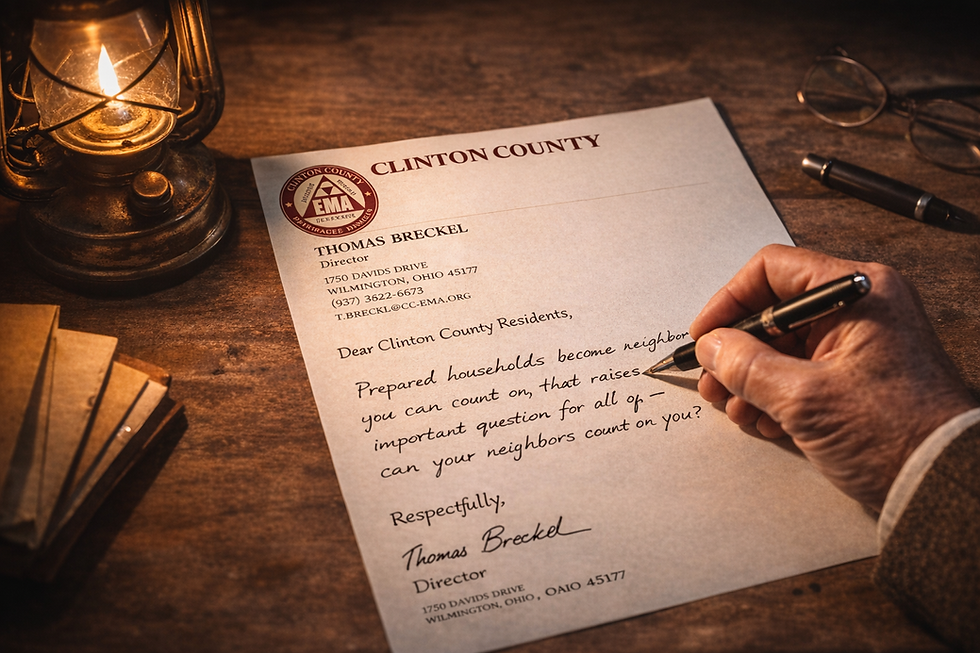Where the Help Helps – And Where It Hurts
- Thomas Breckel

- Jul 8, 2025
- 3 min read
🚨 Where the Help Helps – And Where It Hurts 🚨
This story was shared with EMA by a former active-duty colleague after a powerful conversation they had with a local resident following a recent disaster. I've reworded and emphasized a few elements to protect both the innocent and the guilty—but the message remains crystal clear.
👉 Being a volunteer during a disaster can be life-changing—for better or worse. There’s a fine line between being a helpful asset and a well-intentioned problem.
This story walks that line and highlights the lessons every would-be helper should know before rushing in.
- - - - - - - - - - - - - - - - - - - -
Where the Help Helps – And Where It Hurts

The storm was unlike anything we’d seen. Roads became rivers. Power vanished. Sirens wailed in the distance. I was lucky—our house held. No injuries. No flooding. Just tree limbs down and no cell signal for a while. When things stabilized, I did what I’ve always done: checked on the neighbors. Mrs. Granger had no power, so we got her a flashlight. The Delgados had water creeping in, so I helped move furniture. I did what I could with what I had.
But then I saw the social media posts:
“Kids trapped in a house on the west side!”
“Send boats to Route 366—people are stuck!”
I felt the pull in my gut. I had a truck, some rope, a basic med kit, and an old chainsaw. Should I go?
It felt right. It felt urgent.
What I didn’t know was the post was over 8 hours old—and that situation had already been resolved. I was putting myself and others at risk.
I left my neighborhood that night, pushing past barricades and waterlogged roads. I wasn’t far out before I hit trouble—a downed line I couldn’t see until I was nearly on top of it. I wasn’t injured, but I had to reroute. Then, trying to reach a group of volunteers, I drove onto a flooded side street and stalled. It took hours to get help—and that help came from emergency crews who could’ve been assisting someone in real danger. I was well-meaning, but I became part of the problem.
And I wasn’t alone.
There were others like me—self-dispatched volunteers clogging roads, asking where to help, some even livestreaming while survivors waited for real assistance. Some had chainsaws but no safety gear. One guy showed up at a fire station with a truckload of used clothes, taking up space and time when they needed fuel and bottled water.
Here’s what I wish I’d fully understood before I left home:
➡️ You are your own first responder. Help may not come for hours—or days. Secure your household first.
➡️ Your neighborhood is next. If you help your block, and they help theirs, the whole community lifts together.
➡️ Unassigned = Unwanted interference. By Day 2, emergency missions are being coordinated. If you’re not assigned, you’re disrupting—not helping.
➡️ Be self-contained. If you deploy, don’t consume local food, water, or shelter. Bring 96 hours of everything you need.
➡️ Gear isn’t enough. No PPE with your chainsaw? You’re a risk, not a resource.
➡️ Don’t film it—just do it. Service isn’t measured in views or likes.
➡️ Don’t donate junk. Ask what’s needed. Don’t guess.
➡️ Cash donations go farthest. Trusted local orgs know what survivors actually need and can respond faster with funding.
The recent Texas flooding is a stark reminder. In that incident, well-meaning bystanders nearly disrupted a high-risk water rescue. Those rescuers didn’t need help—they needed space to work. Had things gone wrong, we’d be talking about casualties, not compassion.
Helping matters. We need volunteers. But we need the right help, at the right time, with the right preparation. Otherwise, even the best intentions can become obstacles—or worse.
So, next time disaster strikes, ask yourself: Am I helping the right way—or am I just in the way?






Comments